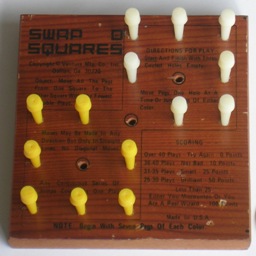


The "English Sixteen" puzzle is peg jumping puzzle that is essentially a two-dimensional analogue of the Leaping Frogs puzzle. The board has two 3×3 grids of holes which share one corner hole. Initially the shared hole is empty, and the rest is filled with eight pegs of one colour in one half of the board and eight pegs of a second colour in the other half. You are allowed to shift a peg to an adjacent hole, or you can jump a peg over another if the hole is immediately behind that. The aim is to swap the colours, moving every peg to the other half of the board in as few moves as possible.
This puzzle is described in Professor Hoffman's "Puzzles Old and New" from 1893.
In some versions of the puzzle you are restricted in your movements by one or both of the following rules:
These restrictions are essentially the same as draughts/checkers, so sometimes this version of the puzzle is played on a checkered board with pieces on the black squares.
| A1 | ||||
|---|---|---|---|---|
| B1 | B2 | |||
| C1 | C2 | C3 | ||
| D1 | D2 | |||
| E1 | ||||
| F1 | F2 | |||
| G1 | G2 | G3 | ||
| H1 | H2 | |||
| I1 |
Swap Squares is a version of the puzzle which starts with only 7 pieces in each half - the centre hole of each 3×3 grid is initially left empty. The same restrictions may be applied if you wish. Note that in this game it is possible to shift/jump one piece several times in succession. You may wish to count multiple consecutive shifts/jumps with one piece as a single move, or only count consecutive jumps as a single move.
If your browser supports JavaScript, then you can play the English Sixteen / Swap Squares puzzle by clicking the link below:
If there are no restrictions on the moves, then it is easy to calculate the number of positions. There are 17 holes, and 8 pegs of each colour, giving a total of 17!/8!2 = 218,790 positions. If only forwards moves are allowed, then many of these positions are unreachable. It is difficult to calculate the number directly, but a full enumeration by computer showed there are 133,864 reachable positions.
| Any direction | Forward only Jump any colour | Forward only Jump opposite colour | |||||||||||||||||||||||||||||||||||||||||||||||||||||||||||||||||||||||||||||||||||||||||||||||||||||||||||||||||||||||||||||||||||||||||||||||||||||||||||||||||||||||||||||||||||||||||||||||||||||||||||||||||||||||||||||||||||||||||||||||||||||||||||||||||||||||||||||||||||||||||||||||||||||||||||||||||
|---|---|---|---|---|---|---|---|---|---|---|---|---|---|---|---|---|---|---|---|---|---|---|---|---|---|---|---|---|---|---|---|---|---|---|---|---|---|---|---|---|---|---|---|---|---|---|---|---|---|---|---|---|---|---|---|---|---|---|---|---|---|---|---|---|---|---|---|---|---|---|---|---|---|---|---|---|---|---|---|---|---|---|---|---|---|---|---|---|---|---|---|---|---|---|---|---|---|---|---|---|---|---|---|---|---|---|---|---|---|---|---|---|---|---|---|---|---|---|---|---|---|---|---|---|---|---|---|---|---|---|---|---|---|---|---|---|---|---|---|---|---|---|---|---|---|---|---|---|---|---|---|---|---|---|---|---|---|---|---|---|---|---|---|---|---|---|---|---|---|---|---|---|---|---|---|---|---|---|---|---|---|---|---|---|---|---|---|---|---|---|---|---|---|---|---|---|---|---|---|---|---|---|---|---|---|---|---|---|---|---|---|---|---|---|---|---|---|---|---|---|---|---|---|---|---|---|---|---|---|---|---|---|---|---|---|---|---|---|---|---|---|---|---|---|---|---|---|---|---|---|---|---|---|---|---|---|---|---|---|---|---|---|---|---|---|---|---|---|---|---|---|---|---|---|---|---|---|---|---|---|---|---|---|---|---|---|---|---|---|---|---|---|---|---|---|---|---|---|---|---|---|---|---|---|---|---|---|
|
|
|
|
|
| ||||||||||||||||||||||||||||||||||||||||||||||||||||||||||||||||||||||||||||||||||||||||||||||||||||||||||||||||||||||||||||||||||||||||||||||||||||||||||||||||||||||||||||||||||||||||||||||||||||||||||||||||||||||||||||||||||||||||||||||||||||||||||||||||||||||||||||||||||||||||||||||||||||||||||||||
In the 14 peg game, 7 pegs of each colour and 3 empty holes, giving 17!/(7!23!) = 2,333,760 positions if there are no restrictions on the moves. If we restrict to forward moves only, then there are 2,071,392 reachable positions.
| Every jump and shift counts as a move | |||||||||||||||||||||||||||||||||||||||||||||||||||||||||||||||||||||||||||||||||||||||||||||||||||||||||||||||||||||||||||||||||||||||||||||||||||||||||||||||||||||||||||||||||||||||||||||||||||||||||||||||||||||||||||||||||||||||||||||||||||||||||||||||||||||||||
|---|---|---|---|---|---|---|---|---|---|---|---|---|---|---|---|---|---|---|---|---|---|---|---|---|---|---|---|---|---|---|---|---|---|---|---|---|---|---|---|---|---|---|---|---|---|---|---|---|---|---|---|---|---|---|---|---|---|---|---|---|---|---|---|---|---|---|---|---|---|---|---|---|---|---|---|---|---|---|---|---|---|---|---|---|---|---|---|---|---|---|---|---|---|---|---|---|---|---|---|---|---|---|---|---|---|---|---|---|---|---|---|---|---|---|---|---|---|---|---|---|---|---|---|---|---|---|---|---|---|---|---|---|---|---|---|---|---|---|---|---|---|---|---|---|---|---|---|---|---|---|---|---|---|---|---|---|---|---|---|---|---|---|---|---|---|---|---|---|---|---|---|---|---|---|---|---|---|---|---|---|---|---|---|---|---|---|---|---|---|---|---|---|---|---|---|---|---|---|---|---|---|---|---|---|---|---|---|---|---|---|---|---|---|---|---|---|---|---|---|---|---|---|---|---|---|---|---|---|---|---|---|---|---|---|---|---|---|---|---|---|---|---|---|---|---|---|---|---|---|---|---|---|---|---|---|---|---|---|---|---|---|---|---|---|---|
| Any direction | Forward only Jump any colour | Forward only Jump opposite colour | |||||||||||||||||||||||||||||||||||||||||||||||||||||||||||||||||||||||||||||||||||||||||||||||||||||||||||||||||||||||||||||||||||||||||||||||||||||||||||||||||||||||||||||||||||||||||||||||||||||||||||||||||||||||||||||||||||||||||||||||||||||||||||||||||||||||
|
|
|
|
|
| ||||||||||||||||||||||||||||||||||||||||||||||||||||||||||||||||||||||||||||||||||||||||||||||||||||||||||||||||||||||||||||||||||||||||||||||||||||||||||||||||||||||||||||||||||||||||||||||||||||||||||||||||||||||||||||||||||||||||||||||||||||||||||||||||||||
| Consecutive jumps with the same piece count as one move | |||||||||||||||||||||||||||||||||||||||||||||||||||||||||||||||||||||||||||||||||||||||||||||||||||||||||||||||||||||||||||||||||||||||||||||||||||||||||||||||||||||||||||||||||||||||||||||||
|---|---|---|---|---|---|---|---|---|---|---|---|---|---|---|---|---|---|---|---|---|---|---|---|---|---|---|---|---|---|---|---|---|---|---|---|---|---|---|---|---|---|---|---|---|---|---|---|---|---|---|---|---|---|---|---|---|---|---|---|---|---|---|---|---|---|---|---|---|---|---|---|---|---|---|---|---|---|---|---|---|---|---|---|---|---|---|---|---|---|---|---|---|---|---|---|---|---|---|---|---|---|---|---|---|---|---|---|---|---|---|---|---|---|---|---|---|---|---|---|---|---|---|---|---|---|---|---|---|---|---|---|---|---|---|---|---|---|---|---|---|---|---|---|---|---|---|---|---|---|---|---|---|---|---|---|---|---|---|---|---|---|---|---|---|---|---|---|---|---|---|---|---|---|---|---|---|---|---|---|---|---|---|---|---|---|---|---|---|---|---|---|
| Any direction | Forward only Jump any colour | Forward only Jump opposite colour | |||||||||||||||||||||||||||||||||||||||||||||||||||||||||||||||||||||||||||||||||||||||||||||||||||||||||||||||||||||||||||||||||||||||||||||||||||||||||||||||||||||||||||||||||||||||||||||
|
|
|
|
|
| ||||||||||||||||||||||||||||||||||||||||||||||||||||||||||||||||||||||||||||||||||||||||||||||||||||||||||||||||||||||||||||||||||||||||||||||||||||||||||||||||||||||||||||||||||||||||||
| Consecutive shifts and jumps with the same piece count as one move | |||||||||||||||||||||||||||||||||||||||||||||||||||||||||||||||||||||||||||||||||||||||||||||||||||||||||||||||||||||||||||||||||||||||||||||||||
|---|---|---|---|---|---|---|---|---|---|---|---|---|---|---|---|---|---|---|---|---|---|---|---|---|---|---|---|---|---|---|---|---|---|---|---|---|---|---|---|---|---|---|---|---|---|---|---|---|---|---|---|---|---|---|---|---|---|---|---|---|---|---|---|---|---|---|---|---|---|---|---|---|---|---|---|---|---|---|---|---|---|---|---|---|---|---|---|---|---|---|---|---|---|---|---|---|---|---|---|---|---|---|---|---|---|---|---|---|---|---|---|---|---|---|---|---|---|---|---|---|---|---|---|---|---|---|---|---|---|---|---|---|---|---|---|---|---|---|---|---|---|---|---|---|---|
| Any direction | Forward only Jump any colour | Forward only Jump opposite colour | |||||||||||||||||||||||||||||||||||||||||||||||||||||||||||||||||||||||||||||||||||||||||||||||||||||||||||||||||||||||||||||||||||||||||||||||
|
|
|
|
|
| ||||||||||||||||||||||||||||||||||||||||||||||||||||||||||||||||||||||||||||||||||||||||||||||||||||||||||||||||||||||||||||||||||||||||||||
Without the restrictive rules, the optimal solution is 46 moves (20 shifts and 26 jumps). Unsurprisingly, there are no backwards moves, so the first restriction makes no difference. More surprising is that there are such optimal solutions where jumps are only performed over pieces of the opposite colour. The second restriction therefore also makes no difference to the length of the shortest solution (although there are more optimal solutions if you do not impose the second restrictive rule).
Here is one of many 46 move solutions:
D2-E1 F1xD2 G1-F1 E1xG1 D1-E1 F2xD1 G3-F2 E1xG3 C3xE1 B2-C3 D1xB2 F2xD1 E1-F2 C3xE1 D2-C3 F1xD2 G2-F1 F2-G2 H1xF2 G1-H1 I1xG1 G3xI1 E1xG3 C1xE1 B1-C1 D2xB1 F1xD2 G1-F1 E1xG1 C1xE1 A1xC1 B1-A1 D2xB1 F1xD2 H2xF1 G3-H2 E1xG3 C1xE1 D1-C1 C2-D1 D2-C2 F1xD2 E1-F1 F2-E1 D1xF2 E1-D1
Suppose we only apply the first restrictive rule, so moves are only forwards, and there is no
restriction on the colours of pieces we jump over. In this case there are solutions which are
optimal whichever way you count the moves. It has 38 shifts/jumps, 24 moves when only consecutive
jumps with the same piece are combined to one move, and 18 moves if consecutive shifts/jumps of
the same piece are also combined.
Here is one such solution:
B1-C2 F1-E1 H2-G2 D2xF1xH2 G1-F1xD2xB1 C3-D2xF1 E1-F2 I1xG1xE1xC3 C1xE1xG1xI1 A1xC1xE1xG1 G3xE1xC1xA1 D1-E1 F2xD1-C1 B2xD1xF2-G3 H1xF2xD1xB2 C2-D1xF2xH1 G2-F2xD1 E1-F2
Allowing backwards moves does not allow for shorter solutions, except if you combine consecutive shifts/jumps of one piece. In that case, a 17 move solution is possible, for example:
F2-E1 D1xF2-G2 H1xF2xD1x-C2 B2xD1xF2xH1 C3-B2xD1xF2 E1-D1xB2 G1xE1-F1 A1xC3xE1xG1 G3xE1xC3xA1 H2-G3xE1xC3 D2-E1xG3-H2 I1xG3xE1-D2 C1xE1xG3xI1 B1-C1xE1xG3 F1-E1xC1 G2-F1 C2-B1
On the other hand if both rules are in effect (forward moves only, jumps only over opposite colour), then the solutions are all slightly longer - 41 shifts and jumps, 31 if consecutive jumps are combined, and 21 if consecutive jumps and shifts are combined. The solution below is optimal in the first two metrics, and the solution below that in the third metric. There is probably no single solution that is optimal in all three.
B1-C2 D1-E1 F2xD1 E1-F2 D2-E1 F1xD2xB2 F2-G2 H2xF1xD2 G3-F2 G1-F1 E1xG1 C1xE1xG3 G3-H2 C3xE1xG3 A1xC1xE1 B2-C3 D1-C1 F2xD1xB2 B2-A1 H1xF2xD1xB2 I1-H1 G1xI1 H1xF2xD1 E1-F2 C3xE1xG1 D2-C3 C2-D2 D2-E1 F1xD2 G2-H1 E1-D1
B1-C2 F2-E1 D1xF2-G2 C1-D1xF2 A1-B1-C1-D1 E1xC1-B1-A1 F1-E1xC1-B1 G1-F1-E1xC1 D2-E1-F1-G1 C3-D2-E1-F2 B2-C3-D2 G3xE1xC3-B2 H2-G3xE1xC3 F2-G3-H2 D2-E1-F2-G3 H1xF2-E1-D2 I1-H1xF2-E1 G2-H1-I1 D1xF2-G2-H1 C2-D1xF2 E1-D1